The legendary Omega Seamaster Ploprof – The Kraken of Diving Watches
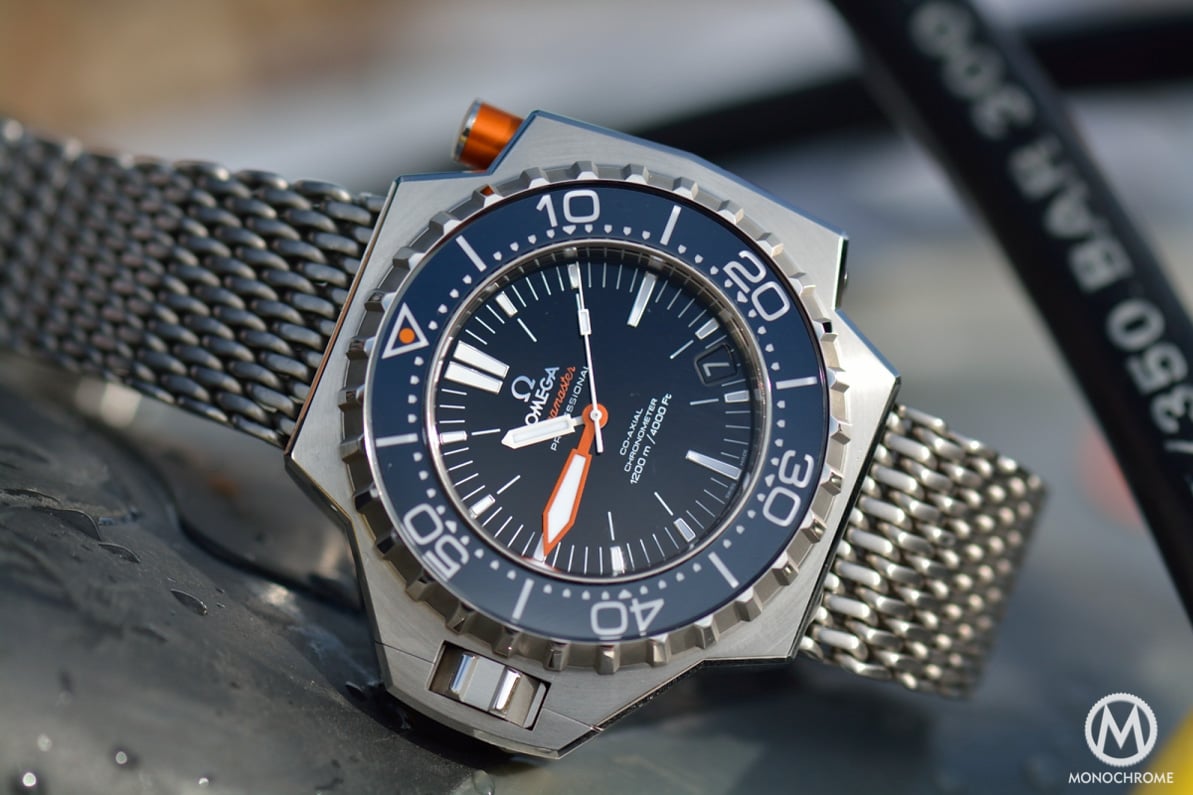
The world of diving watches has a very unique place in the industry. There are very cheap divers and very expensive ones, there are watches that can be used as a backup for the dive computers, because they calculate the depth as well other parameters as ascend/descend rate, water temperature etc, and there are watches that are very minimal. There are automatic, quartz, kinetic or solar driven. There are tools and there are jewels or as we call them the desk divers. Some of them though are so important because upon their inception they transformed the way the industry perceived the construction of the proper divers watch. One such icon we are going to examine today because in truth few examples possess the presence and the mystic that surrounds the Omega Seamaster Ploprof.
* Kraken is a legendary sea monster of large proportions. The sheer size and fearsome appearance attributed to the kraken have made it a recurring ocean-dwelling monster in various fictional works and movies.
Elements of a Great Divers Watch
Before we examine the archetypal Ploprof 600, and in detail its re-edition that launched in 2009 we must touch the parameters that are fundamental for a good divers watch.
The ability to record time is crucial for all underwater activity. There are a number of different methods of recording the amount of time the diver has spent submerged, including the chronograph functions (see the Omega Seamaster 120m Chronograph Big Blue), the simplest method is the bezel. As many things that are taken for granted nowadays, the rotating bezel in watches has been developed by the armed forces, and was incorporated in dive watches as well with the addition of time marked increments on the ring to allow the elapsed time so as to be easily read. The bezel must be reliable in its use, must have a serrated edge in order to be controlled by the divers usually wearing gloves and also must not be easily knocked off from the position the diver set before the dive.
The case in divers watches is perhaps the most important element in its design since the problem here is the watch to mitigate the force of water pressure. The issue in our case is compressibility, since the watchcases contain an air-filled void housing the movement. The deeper the diver descends, the water surrounding the case becomes pressed more and more against the timepiece. Enough pressure would start to flex the casing parts as the pressure build-up outside is far greater than the pressure inside. To combat this, a proper dive watch must be extremely well engineered and tough, with components cleverly designed like high quality O-rings or extremely machined high grade stainless-steel.
The caliber is hugely important, since it permits the diver to time his descent. The problem here is shock and magnetism. When diving it is very easy to knock the wristwatch on a reef or against a rock since underwater currents are powerful. Impact can cause water ingress due to a ruptured case or a smashed glass, and that’s why the case must be solid, and the glass must be extremely hard (usually sapphire crystal), protected by a thick disc, sealed to the case and secured in place with a locking ring. The force of the knock creates a momentum of its own which continues to act upon the delicate parts inside the watch, even when the outer case has reached a standstill. Violent shocks are the most fatal enemy for a mechanical wristwatch, and the common example of a watch stopping after it falls from our hand or starting to exhibit abnormal timing rate is not rare. A good dive watch must have an extremely well thought-out anti-shock system, and internal shock resistance built into the jewels, which retain the parts of the movement most at risk (Oscillating balance, for example). The ISO standard (we explained it in our review of the Seiko SKX007) for a dive watch covers also the ability of the timepiece to withstand magnetic fields, which can cause components like the gear-train or the hairspring to run poorly. The faraday cage or use of non-metallic hairsprings are ways to deal with this issue.
Last but not least, a proper dive watch must have an improved legibility at depth. The dial must be extremely well thought-out and uncluttered, so the diver cannot make an error when reading his timings during a decompression stop; something that can prove fatal. Divers watches must have, ideally a large colored minute hand that will not be easily confused with any other hand underwater. We must understand that daylight cannot penetrate the depths and colors start to fade after 6 meters. Most well designed divers have bright orange minute hands or even orange dials and have special paint, which glows in the dark placed on strategic places (dial markers, hands, bezel). In the old days manufacturers used Radium, Tritium, and Prometheum – all highly radioactive materials – whereas nowadays the vast majority uses Super-Luninova which is non radioactive and non toxic. Super-Luminova glows when it gathers light instead of glowing all the time like the radioactive materials we already mentioned.
The Archetypal. The Seamaster Ploprof 600 (ref.166.077)
So, a great divers watch must have all of the above elements incorporated in its design, and the Ploprof had them all in abundance right from its inception in the 1970’s. It was after all a tool, created by professional divers in order to be used by professional divers. Its very name denotes its raison-d’etre: Plongeur Professionel (Plo-Prof), which is translated from French as Professional Diver.

The Compagnie Maritime d’Expertise (Comex) was founded in 1961, and pioneered most of the early work in deep sea diving and engineering. From the late 1960’s until the late 1970’s, the iconic Omega Seamaster 300 (ref.165.024) has been used and tested by Comex and also by the divers of Jaqcues-Yves Coustaeu. In the Summer of 1963 Cousteau and his team used the Seamaster 300 in the Red Sea during the Precontinent II experiments. In 1968 Omega agreed to deliver the Seamaster 300 to Comex for some tests for the Physalie experiments and the Janus experiments later that year. Feedback from actual hard use influenced Omega to improve the watch in certain areas, but the most important thing was that a new breed of time keeping apparatus was needed in order to withstand the punishment of the water pressure in the ever increasing depths at which the divers were working.
The Ploprof 600 was revolutionary in many aspects. The case was machined from a single block of stainless steel, and since it was a monobloc design, water could ingress from two points, the crystal and the crown. The crown was designed in a unique way. What appears to be the crown is actually a nut that acts to pull and seal the crown, which is in fact flat and square, sticking out when the tightening nut releases it. So, the square shape prevents the crown from unwinding, locking it flush with the case and also it provides better protection. The bezel locking system was also a first. It used a pushbutton to unlock the bezel mechanism only for setting purposes. The chemically-soaked mineral crystal used was treated with anti-reflective and anti-abrasive material and compressed to 120kg, then held on the gasket by a screw-in ring. It could resist hydrostatic pressures of 60 atmospheres. The dial either in navy blue or black ensured perfect legibility, the minute hand was huge in order to make the procedure of checking the time faster and more precise.
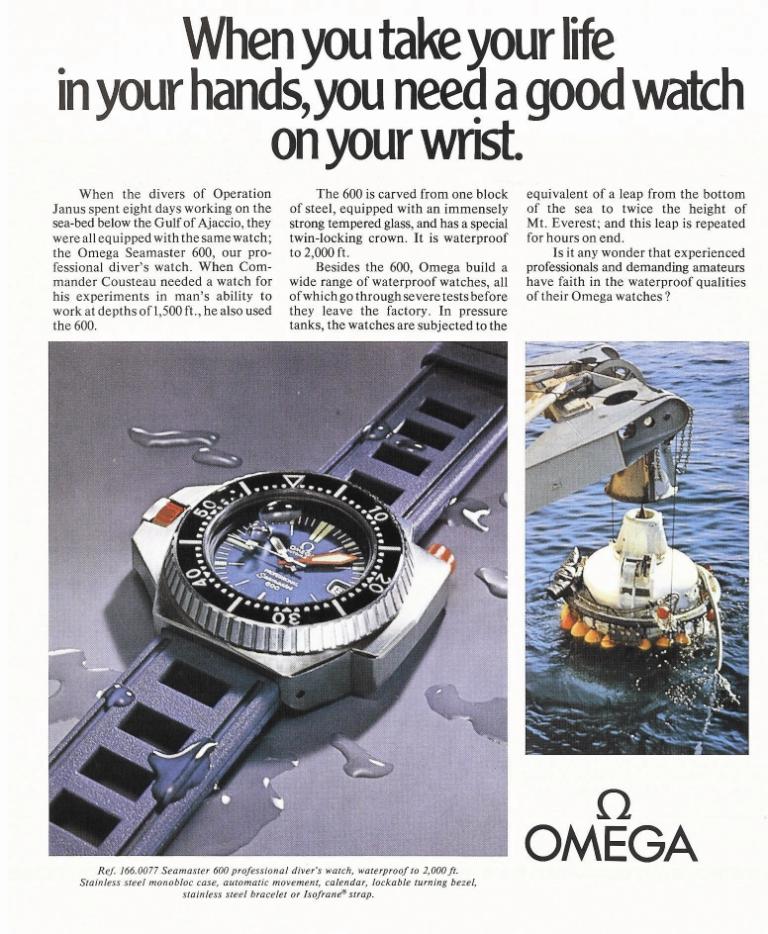
Omega also solved the helium problem following a different route than the competition. Professional divers frequently used diving bells in which they breathed a mixture of helium and oxygen. Helium molecules are much smaller than normal air molecules, and due to high-pressure environments surrounding the watch these molecules passed through the seals and filled the watchcase until the pressure in and out of the watch equalised. When divers decompressed, the helium trapped inside the watch and the unequal pressure created yet again made crystals rupture and explode. Rolex and Doxa created a Helium escape Valve, a clever idea for the helium to expand gradually without destroying the watch. Omega chose to make the Ploprof virtually gas proof. The case was resistant to gasses to such an extent that if the air trapped inside were to be expelled in normal atmospheric conditions, more than 1000 years would go by before it could re-enter. Tests conducted by Omega showed that the Ploprof 600 was one hundred times more water and air-tight than the Apollo Spacecraft, while Comex in September 1970 conducted experiments with three divers for the Janus II operation. The divers spent four hours per day for eight days, and set a world record for underwater exploration at a depth of 253 meters in the Ajaccio Gulf in France. The Ploprof’s record was perfect.
Last but not least, the American Diving research centre Ocean Systems Inc. in Tarrytown NY, tested the Ploprof thoroughly and concluded that the timepiece was more water resistant than a submarine. A series of hypostatic tests revealed that the watch functioned up to a simulated depth of 1370 meters, at which point the 4mm thick crystal touched the second hand, stopping the watch. That’s more than two times the indicated depth rating of the watch!
The Ploprof 600 was the behemoth diving watch. When others used acrylic super domed glass Omega chose a chemically hardened mineral crystal, the bezel lock mechanism, the monobloc case, and the layout of the dial were also technical and design solutions that paved the way from that point onwards for the industry to see how a proper professional divers watch should be constructed. It was a landmark timepiece in every respect and its downside was that it was very expensive; at the time you could buy two Rolex Submariners. The hefty price and its weird looking case meant that the watch did not enjoy commercial success. Nowadays NOS Ploprof 600 examples fetch big money in the market. However, the vintage way is not the only choice if you want to own the watch. Omega re-introduced it in 2009 with few changes.
The return of the Icon. Seamaster Ploprof 1200 (ref.224.30.55.21.01.001)
The new Omega Seamaster Ploprof 1200m is faithful in design to its ancestor but incorporates some differences as well. Although remakes are a very dangerous path for a company, I think that Omega managed to keep the character of the old one, whilst blending in some luxurious new details.

The case is still huge and the conversation element of the watch. With its characteristic shape, it measures 55mm in diameter, 48mm in height and is 17,5 mm thick while it has 24mm lugs. Quite humongous some might say. The case is constructed from very high quality stainless steel but the notable difference is that it is not a monobloc design. The new version has a stainless steel caseback – something that makes the watch much easier to service – and is decorated with the classic seahorse emblem. The button on top of the watch case, that used to be red (plastic), is now orange (metallic), and whilst this is something that adds to the luxury character of the new Ploprof, its functionality remains the same.
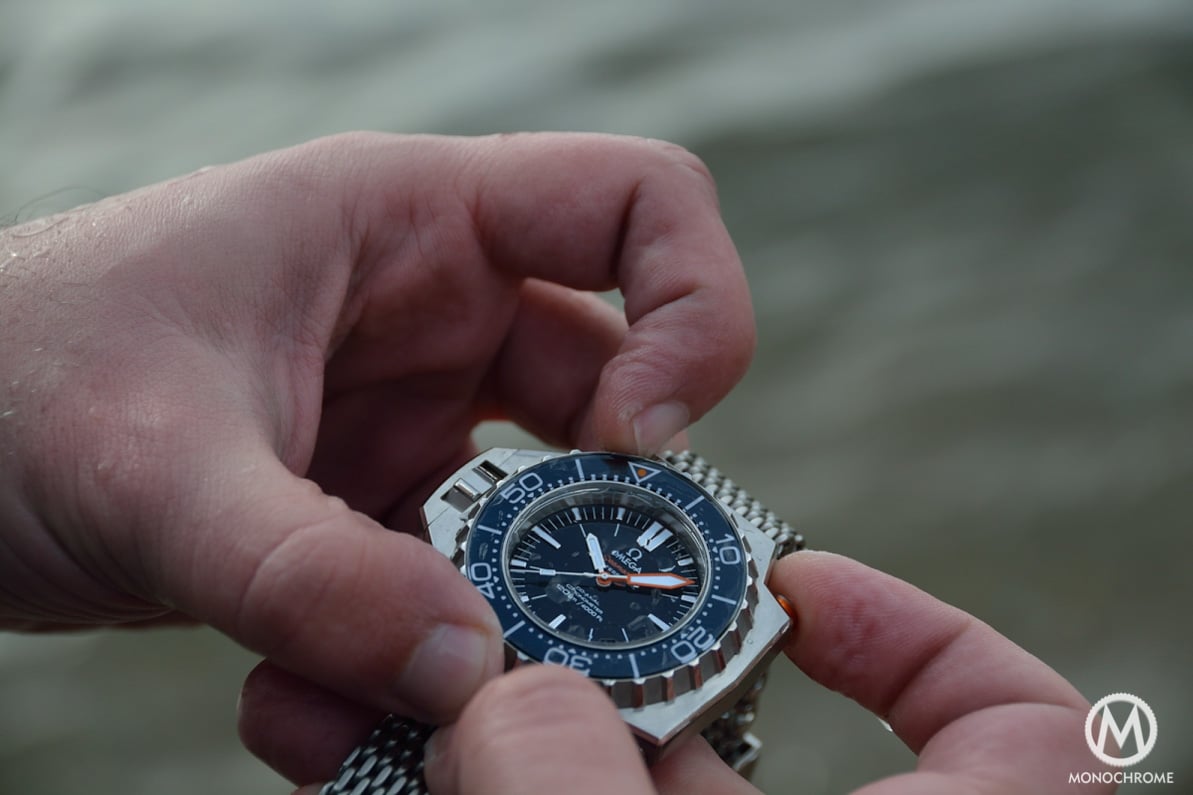
The crown protecting mechanism is essentially the same as the original, you have to unscrew the crown guard before being able to wind the watch and set the time and date. The difference is that the crown guard of the current Ploprof 1200m stays in one piece instead of only unscrewing the top of the crown guard. The dial is another key difference: while it retains the character of its ancestor it oozes quality. There is an applied Omega logo, all the markers are applied as well, something that seems to give the dial a greater sense of depth. Super-luminova that emits a blue colour is generously applied to the dial, hands and the bezel as well. The hands are perfectly finished and the big orange hand is a joy to look at.
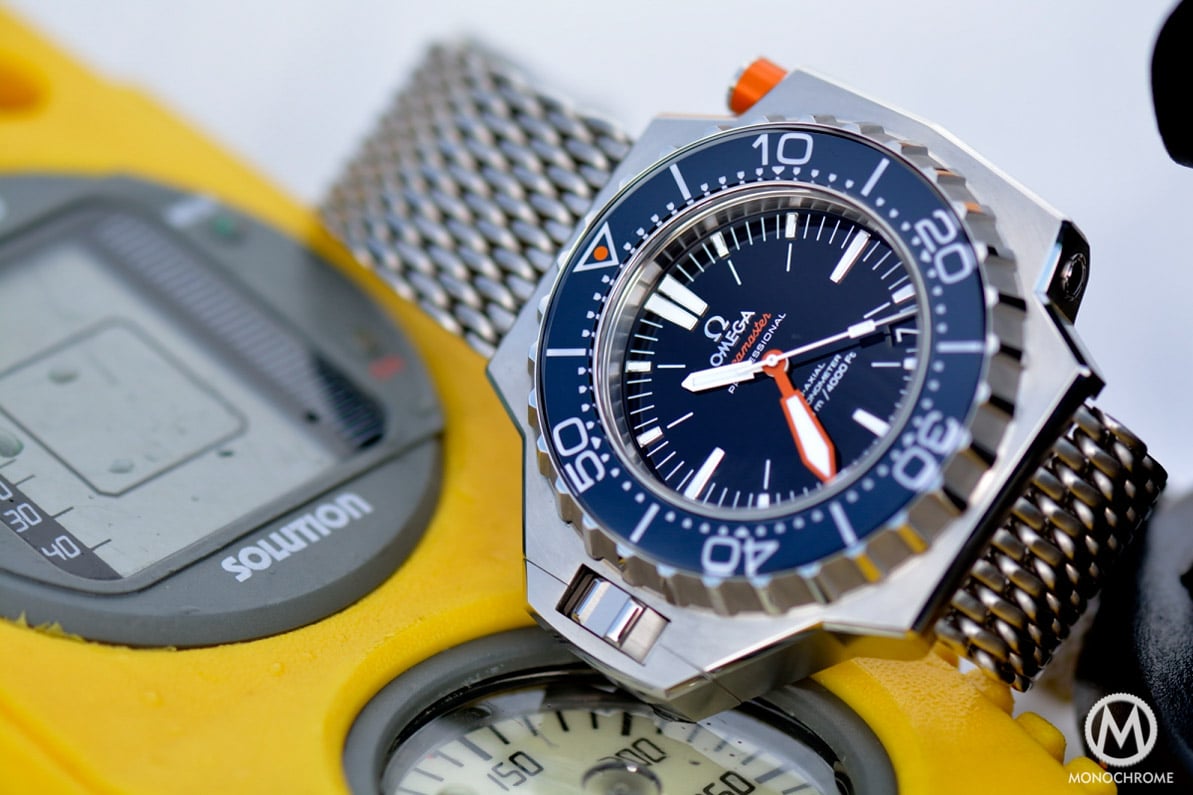
The original Ploprof used the workhorse Cal.1002, a caliber with 20 jewels and date that beat at 28,800A/h and had a power reserve of 42h. The new Ploprof uses the cal.8500 which was developed in-house around a revised Co-Axial escapement. It beats at 25,500A/h with a power reserve of 60h. The calibre gets its power from two DLC (Diamond-like carbon) barrels. The barrels are coated inside to reduce friction and have been tested to simulate over 10 years of use with little wear effect to the DLC. Other talking points of this high-end caliber are an Anachron balance spring, Zircon Oxide rotor pivot jewels, improved Nivachoc shock absorber, and a massive transverse balance bridge. Since 2011, the 8500/8501 have been equipped with the more stable silicon Si14 balance springs. The older versions will be gradually upgraded to Si14 balance springs at service.
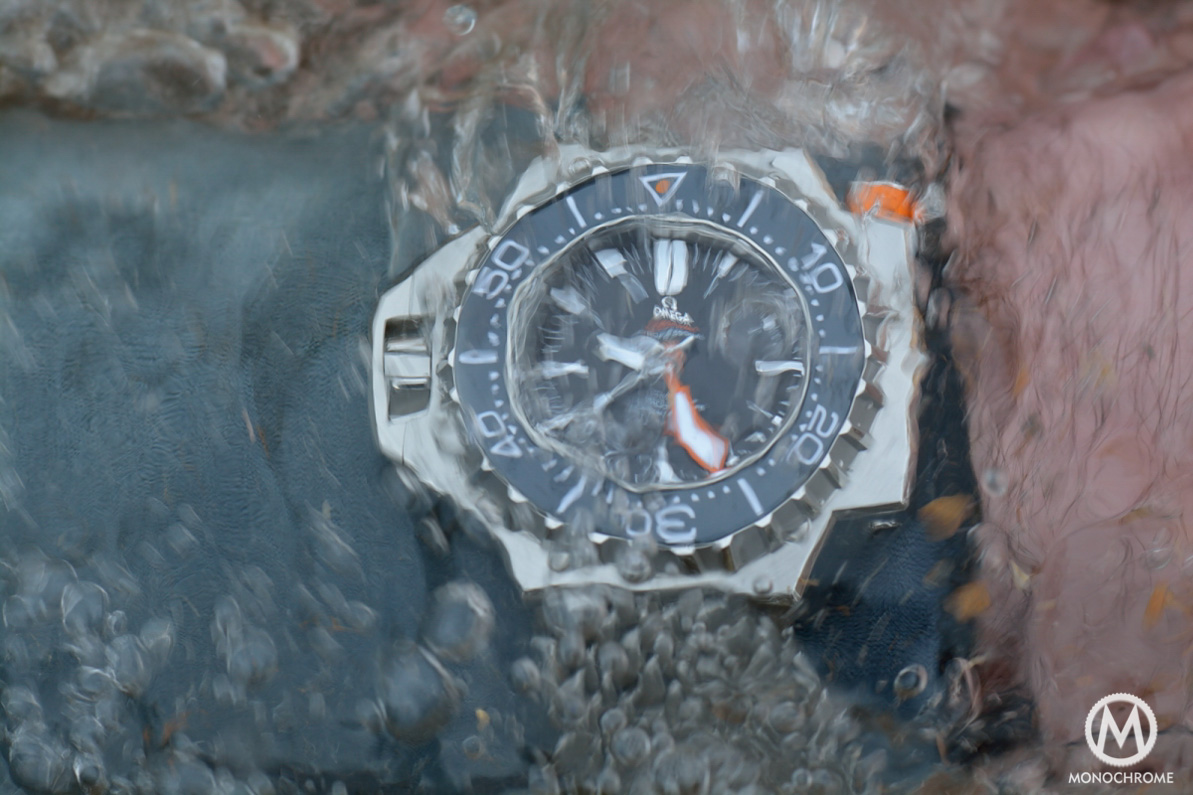
Having the watch for the purpose of this review, I must say that I am completely flabbergasted. Purpose built tool and military watches are my weakness, but the modern Ploprof defied any fears I had. First, the watch has some impressive dimension figures, however here I must add that numbers don’t always tell the truth. The watch is extremely wearable in the vast majority of occasions and the secret here is that it is relatively short from lug to lug. It hides its size pretty well, and it’s very comfortable despite its weight. The automatic Seiko Tuna (ref.SBDX011), the so called Emperor, and a tool dive watch of similar proportions was much more uncomfortable for example. Secondly, the modern Omega Seamaster Ploprof 1200m manages to retain the extreme tool diver character of the old one, embellished with modern design details that makes the watch appeal to the diver and the businessman as well. Last but not least the uniqueness of the Ploprof, which derives from its design, makes it a choice or should I say a statement for its potential buyer. It competes with heavyweights from Rolex like the SeaDweller Deep Sea, the Submersible from Panerai and the Tuna Emperor by Seiko, and manages to surpass them because it offers an amalgam of tool and luxury elements which its competitors do not possess. What struck me when I wore the Ploprof was that anyone who saw it, from people who know about watches and for those that don’t, commented positively about its quality of construction followed by the coolness factor it possess in abundance I think.
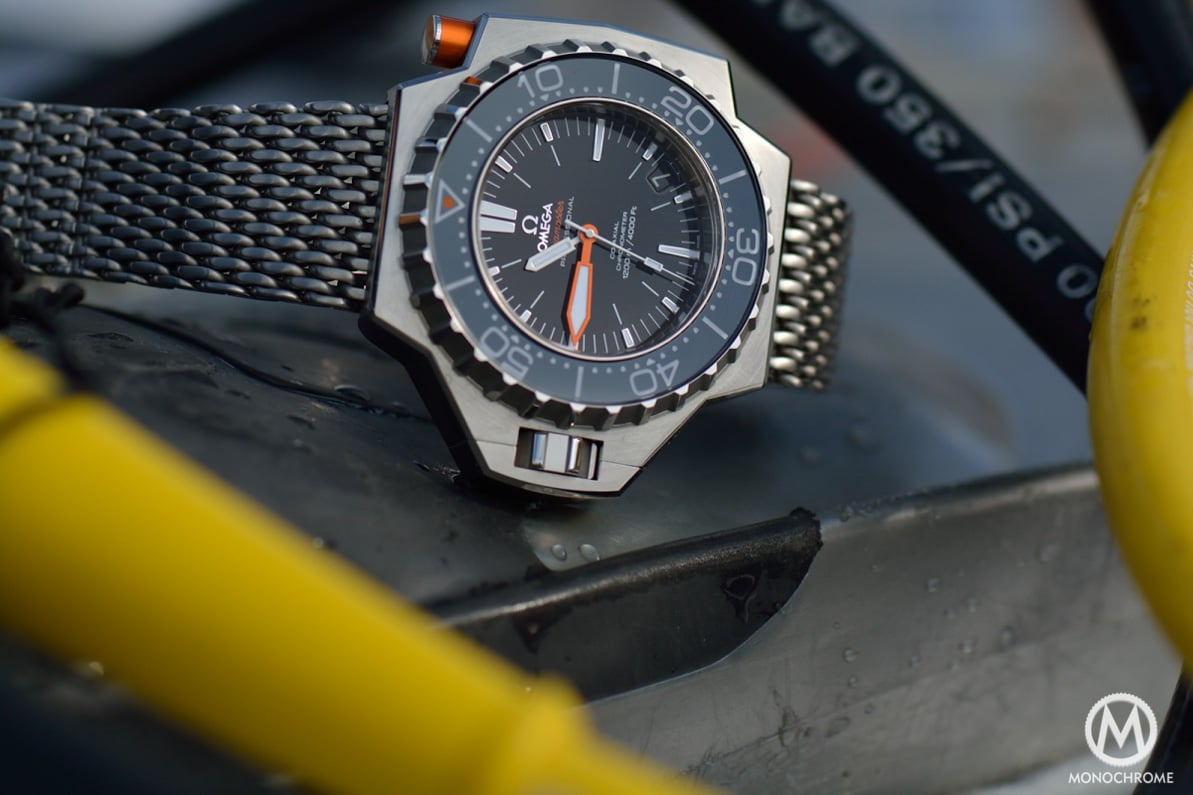
Perhaps one of the coolest watches ever built, the Omega Seamaster Ploprof is a true icon in the industry. Due to its size, shape and the technical and designing solutions it incorporated, the Ploprof paved the way for others to follow. Its introduction made companies like Seiko introduce another iconic diver, the Seiko Tuna in 1975 for example. The Ploprof, developed and built in accordance with the specifications of the professionals, to solve issues that production watches up to that point, faced in the inhospitable depths, and as such it can be said that it is perhaps the first ever purpose built diver. Last but not least, the two generations of the Ploprof highlight the radical transformation of the divers watch in general – an issue that we have touched on in previous articles as well. The stiff-necked original became a much more refined and extravagant timepiece. Despite that Omega, as we already foretold, achieved in keeping to a large extent the tool character that characterizes the Ploprof. It was a bold move to reproduce a watch that is the perfect hardcore purpose built diver; and this move succeeded in every way.
Reference articles used in the review:
– Wallis, John. Dive Watch Mechanics. Below the Surface (Omega Timelife Magazine. Issue 8,2011).
– A Progression of Movements: Omega 2500 & 8500 Calibers. Jeff Bernard – http://www.bernardwatch.com/blog/omega-2500-8500-movements/
– Omega Seamaster Professional 600m/2000ft Review – http://www.ploprof.com/PloProf.html

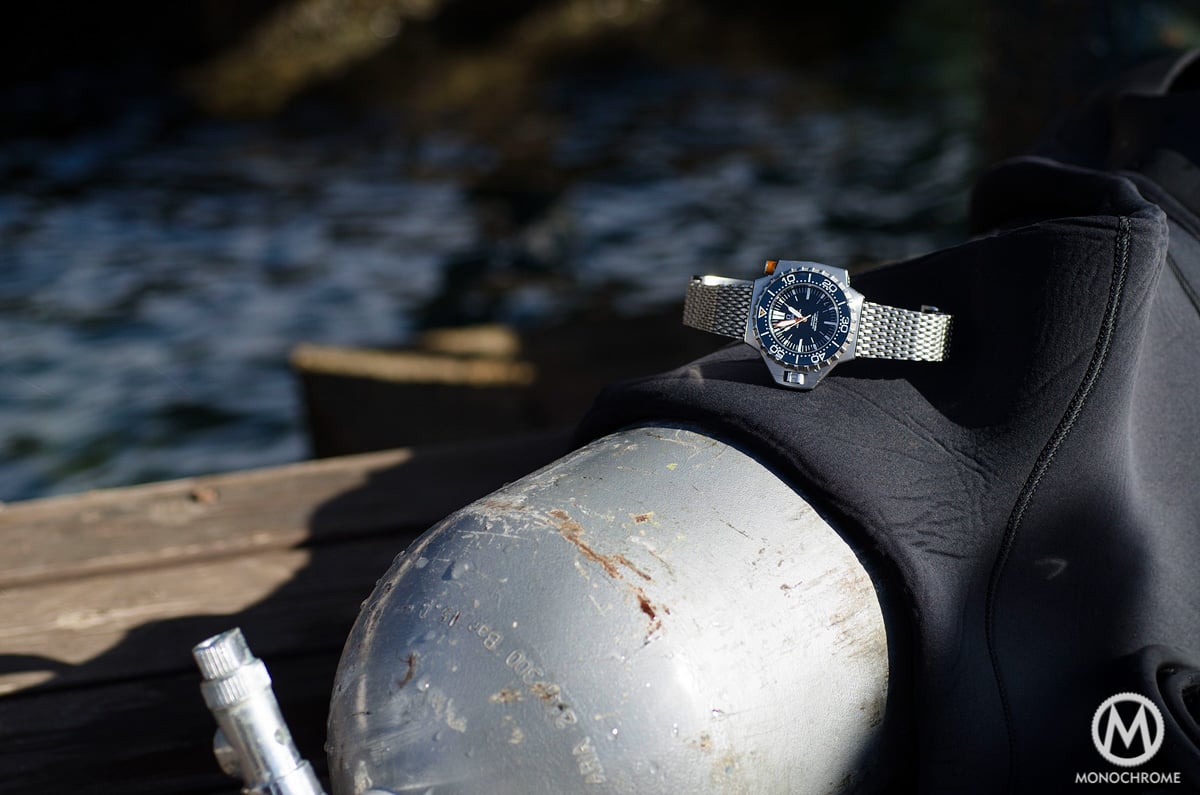
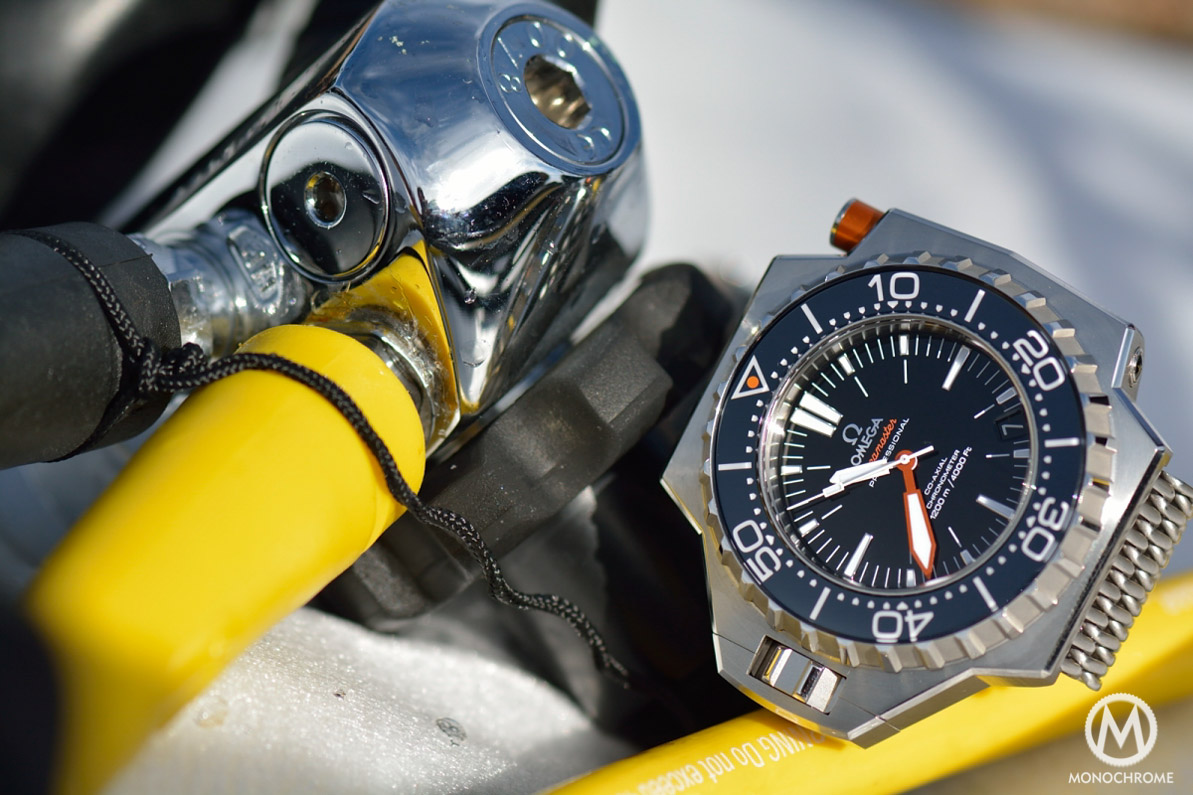

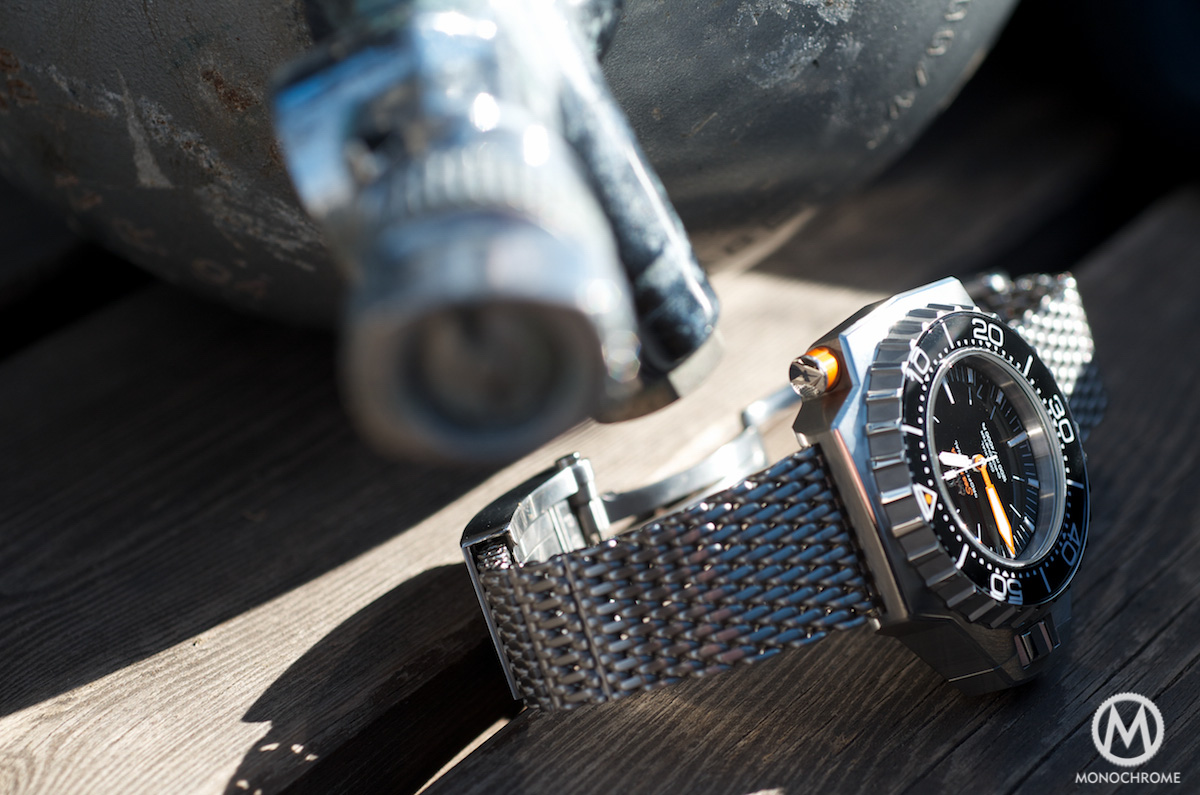
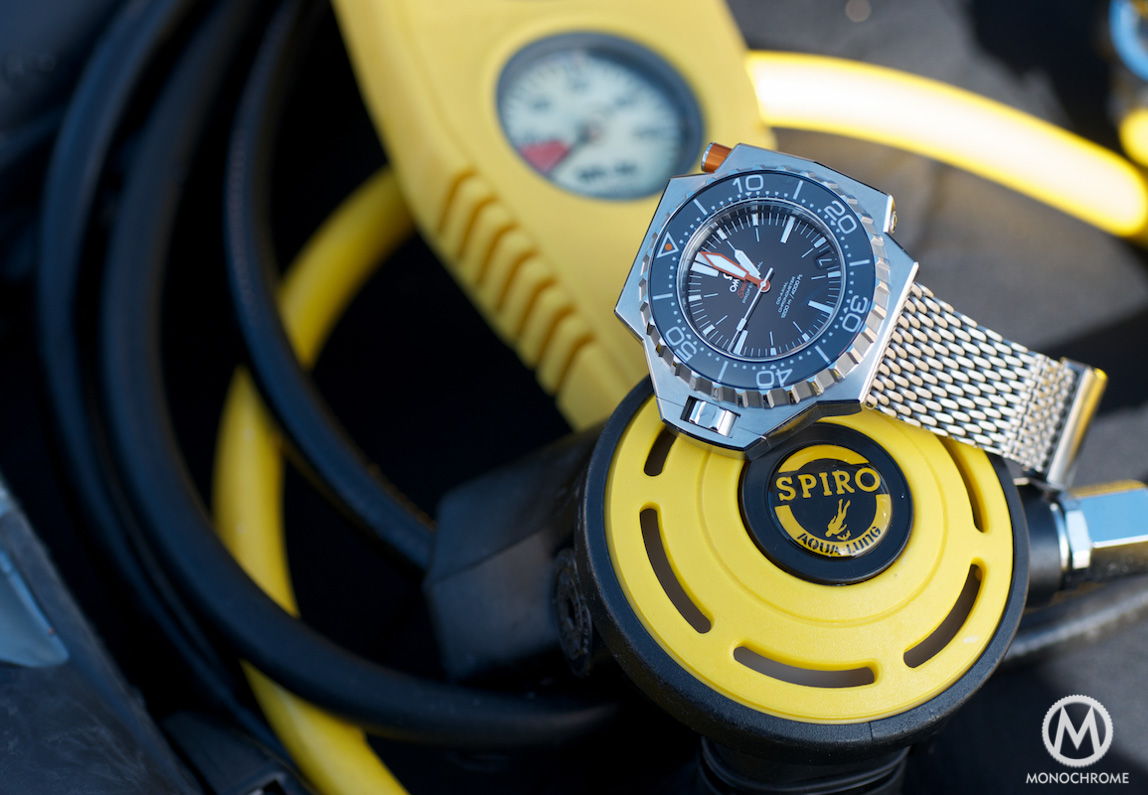
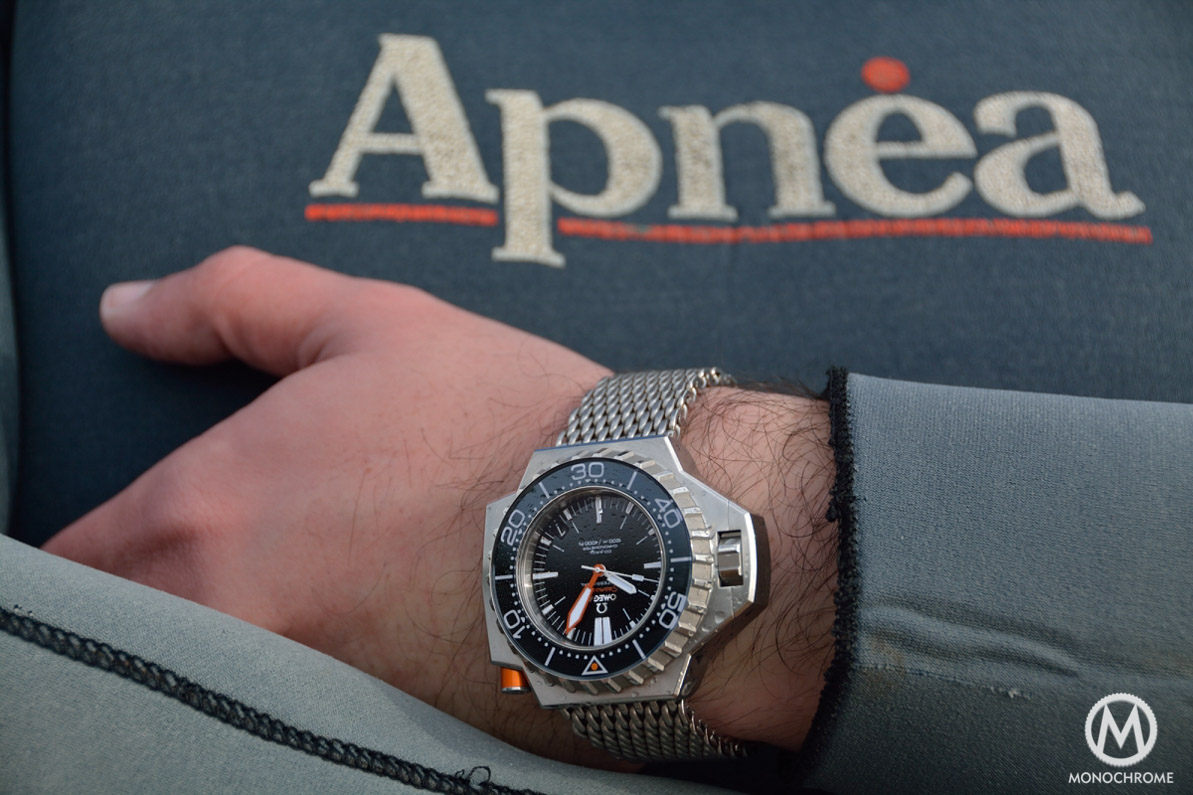
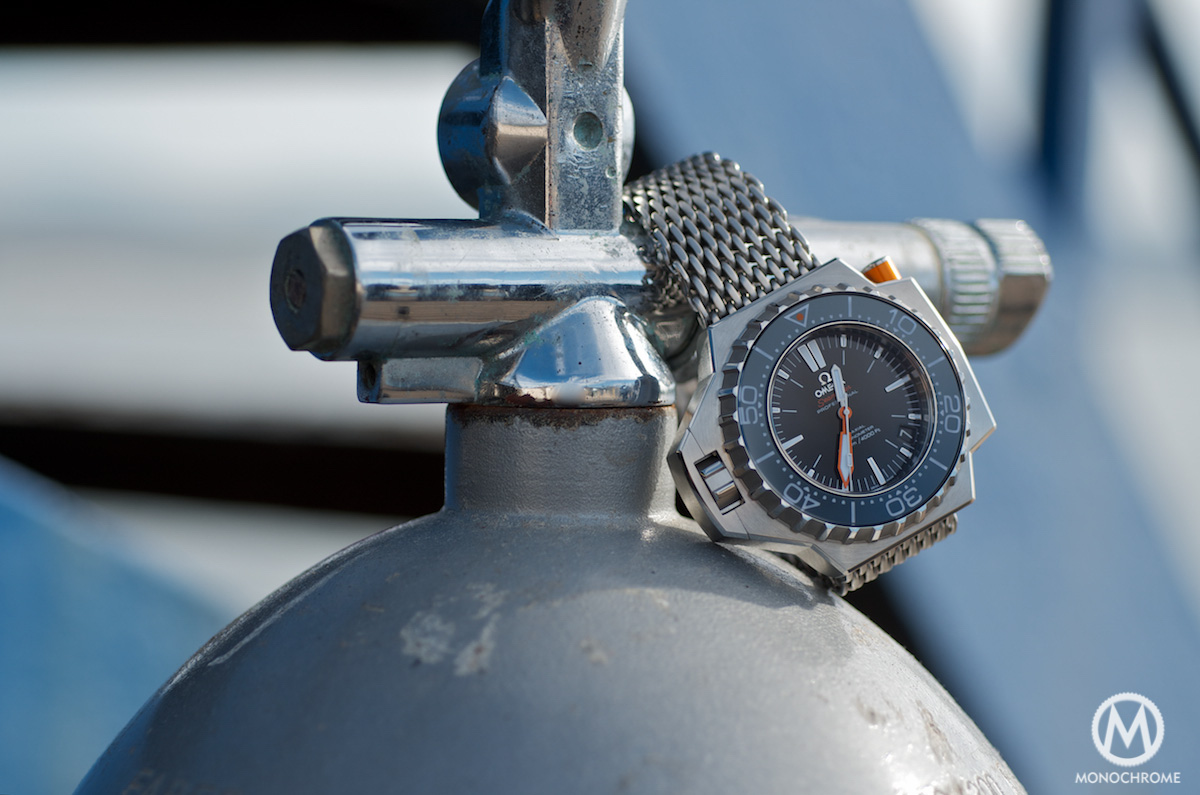


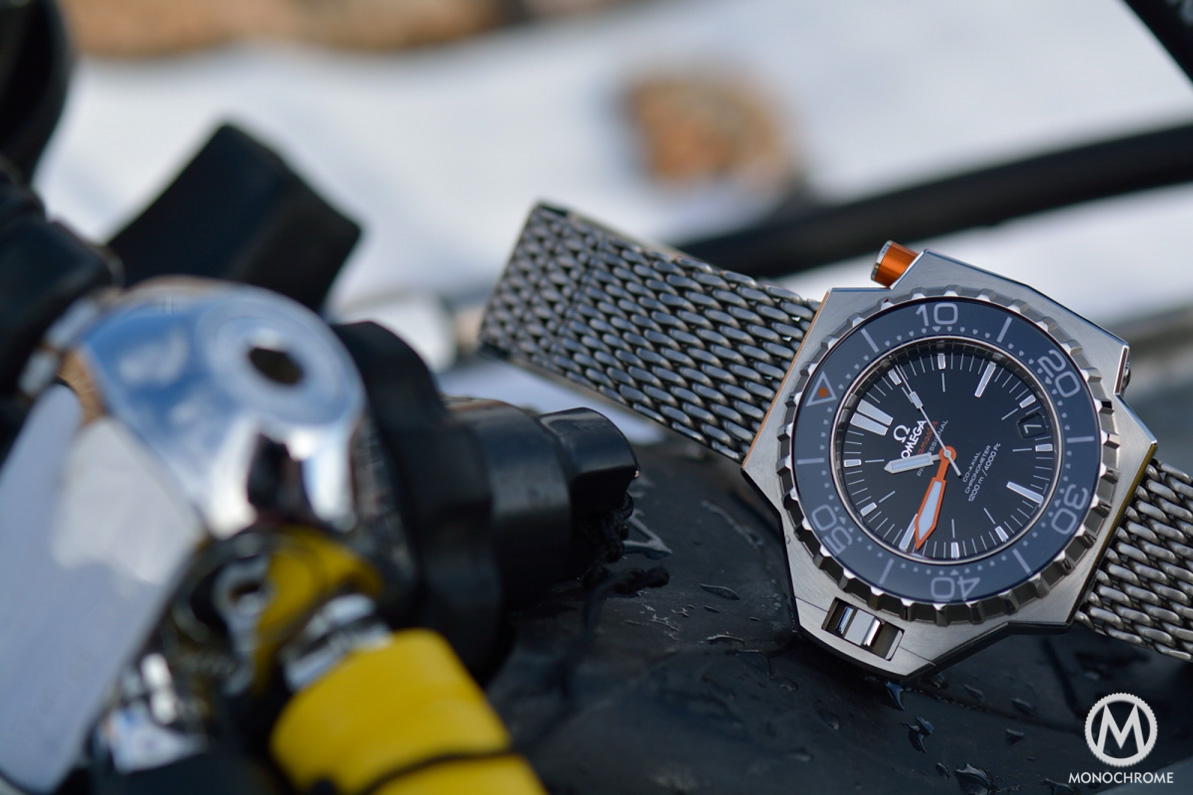


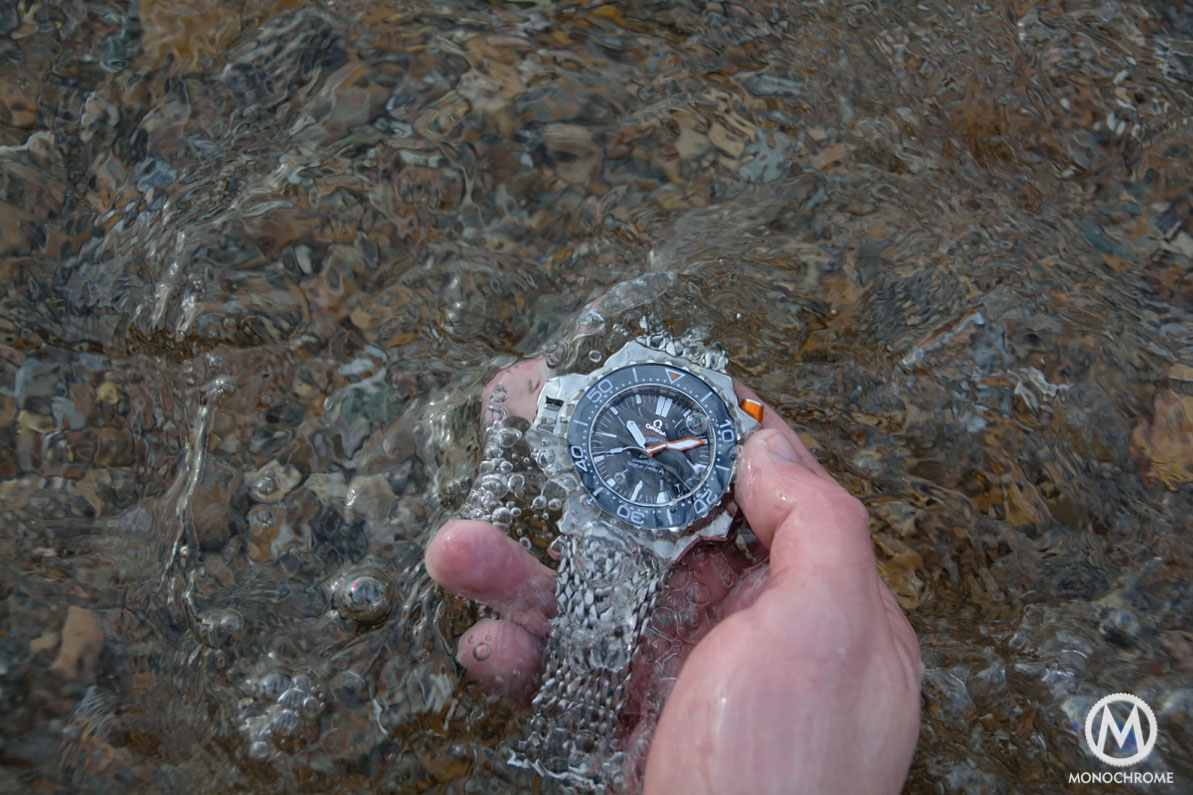


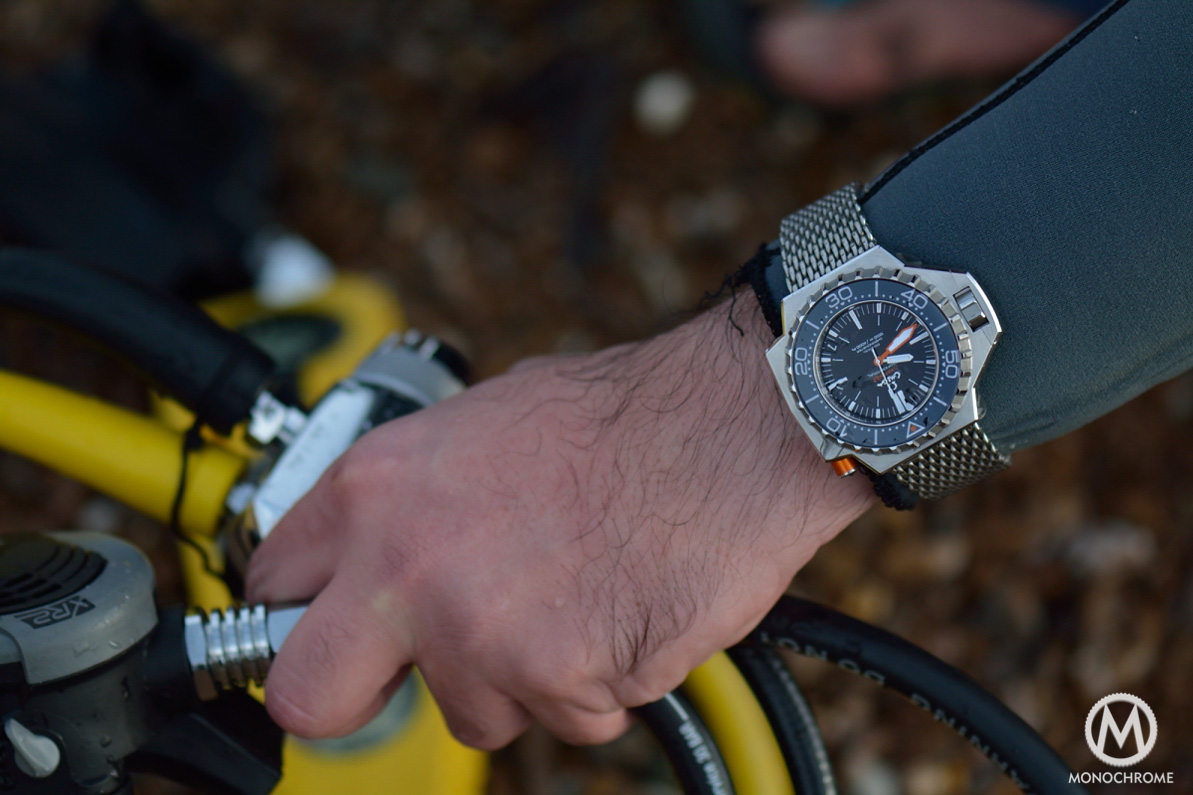




7 responses
Although i am not known for being a non-chronograph fan, i can do nothing but praise; not only the extent of in depth research that went into this article, together with a set of photographs which are of the finest aesthetic, but the special feeling of a certain kind of sentiment which shows all over it as well.
And as far as i am concerned, this is precisely what makes the difference.
A big respect.
X
Amazing article with extreme knowledge and details. This article is a benchmark for gaining all the information needed for a diver’s watch. Excellent job Mr. Giannopoulos.
By far one of the best articles written so far. Very informative and detailed.
This article should be the benchmark of watch literature. I am obsessed with the Ploprof having purchased the 1200 in September of last year. The Regent Street Omega flagship didn’t even display the Ploprof because “no-one ever buys them”! I have a Submariner too but the Ploprof is more comfortable (worn on the left wrist) so the Rolex lives in my safe. The more I wear this Omega the more I like it which is the reverse of what I usually experience.
You mention that the functionality of the button ‘remains the same’, but if I’m not mistaken, you don’t actually say what that functionality is! I can probably google it and find out, but in an article talking about the watch, I’d expect to see it mentioned. Apologies if I have overlooked it.
Thank you for this comment and no worries, you didn’t overlook it…
The button is used to unlock the rotating bezel and to allow it turning.
Hope this will help.
What i miss in your report is the fact that the new Ploprof has a helium valve to relese helium after a saturation dive.Due to the step back from the original monobloc case to a conventional watch case with a opening in the back ( for easyer service…). And i see a lot of pictures in your report, but even if you talk about the back of the case, i can not see this change in one single picture! Also the added helium valve is not documentet in your pictures. Your report is missing some important facts.